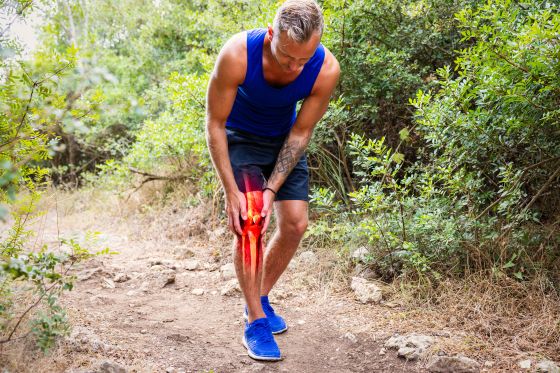Knee pain can stem from various sources, including injuries, overuse, or post-surgery recovery.
For those of us who love to stay active, knee pain can be a significant barrier to enjoying our favourite activities, especially as summer approaches and the weather is finally starting to improve!
The emotional impact of being sidelined due to knee pain after walking can be overwhelming, making it hard to partake in family activities, social events, or simply enjoying the outdoors.
When the sunshine beckons, the last thing anyone wants is to be held back by knee pain.
Whether it’s missing out on a beautiful walk in the park, playing with your kids or grandkids, or participating in a beloved sport, knee pain can drastically reduce your quality of life.
But there’s hope. With the right exercises, you can strengthen your knees and enjoy a pain-free, active summer.
Our Top 5 Exercises To Prevent Knee Pain After Walking
Step-Ups
Strengthen your knees with this simple exercise!
How To:
- Find a sturdy step or platform.
- Step up with your right foot, ensuring your whole foot is on the platform.
- Push through your right foot to lift your body up, bringing your left foot to meet the right.
- Step down with your right foot, followed by your left.
- Repeat 10-15 times on each leg.
Benefits:
- Low-impact and gentle on your knees while offering lots of strengthening benefits.
- Enhances balance and stability, reducing fall and injury risk, especially during everyday activities.
Lunges
Improve flexibility and ease knee pain!
How To:
- Stand tall with feet hip-width apart.
- Step forward with your right leg, lowering your body until your right thigh is parallel to the ground.
- Ensure your knee does not go past your toes and keep your left leg bent at the knee.
- Push through your right heel to return to the starting position.
- Repeat 10-15 times on each leg.
Benefits:
- Stretches the hip flexors and increases flexibility, easing pressure on your knees.
- Improves coordination between hip, knee, and ankle joints, promoting smooth and efficient movements.
Squats
Boost knee stability and strength!
How To:
- Stand with feet shoulder-width apart, toes pointing slightly outwards.
- Lower your body as if sitting back into a chair, keeping your chest up and knees over your toes.
- Go as low as comfortable, ideally until your thighs are parallel to the ground.
- Push through your heels to return to the starting position.
- Repeat 10-15 times.
Benefits:
- Strengthens muscles around the knee, like the quadriceps, calves, and hamstrings, enhancing overall knee stability.
- Encourages proper alignment of the knees and ankles, helping to prevent injuries and ease pain.
Bridges
Strengthen your glutes and support your knees!
How To:
- Lie on your back with your knees bent and feet flat on the floor, hip-width apart.
- Place your arms by your sides, palms facing down.
- Lift your hips towards the ceiling, squeezing your glutes at the top.
- Hold for a few seconds, then lower your hips back to the starting position.
- Repeat 10-15 times.
Benefits:
- Strengthens the glutes, which support the knees and help to alleviate knee pain.
- Improves core stability, which contributes to better overall alignment and knee support.
Leg Raises
Target the outer thighs and knees!
How To:
- Lie on your side with your legs straight and stacked on top of each other.
- Prop your head up with your hand, or rest it on your arm.
- Lift your top leg as high as you can, keeping it straight and toes pointed forward.
- Lower your leg back down with control.
- Repeat 10-15 times on each leg.
Benefits:
- Strengthens the hip abductors and outer thighs, providing better support to the knees.
- Helps to improve balance and stability, reducing the risk of knee injuries.
The Role of Orthotics in Preventing Knee Pain After Walking
Orthotics are a fantastic tool for anyone who enjoys walking, hiking, or running.
They provide essential support and alignment, not just for your feet but for your entire kinetic chain.
Imbalances or issues with your feet can cause problems further up the chain, leading to knee pain.
By correcting your gait and posture, orthotics can help alleviate knee pain after walking, allowing you to move more comfortably and efficiently.
Orthotics can correct unusual gait and posture that cause compensation patterns, resulting in pain and discomfort.
By ensuring proper alignment, orthotics reduce the strain on your knees, helping to prevent injuries and ease existing pain.
Remember, it’s important to look at the body as a whole and correct any issues to avoid compensation patterns that lead to pain.
Get Ready to Leave Knee Pain in the Dust!
We’re offering you a FREE Knee Pain Telephone Consultation!
This is your chance to speak to one of our expert physiotherapists, share your story, discuss your concerns, and discover what treatment options are available to you.
At Paul Gough Physio Rooms, we’re dedicated to helping you regain mobility and live pain-free.
Claim your virtual assessment today! Just get in touch with us or visit our website to schedule your FREE Telephone Consultation now.
Other Free Resources For Reducing Knee Pain After Walking, Running, Or Any Other Activity!
Read Our Blog – How To Reduce Knee Pain When Cycling – Plus 7 Easy Exercises To Keep You In The Saddle
Read Our Blog – Running Tips For Beginners – Avoid Injuries And Improve Your Health
Read Our Blog – Do Orthotics Really Work? YES – And Here’s How!


